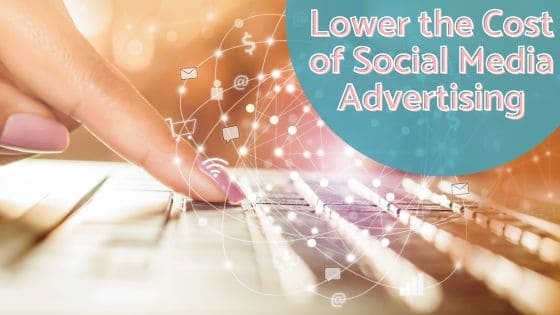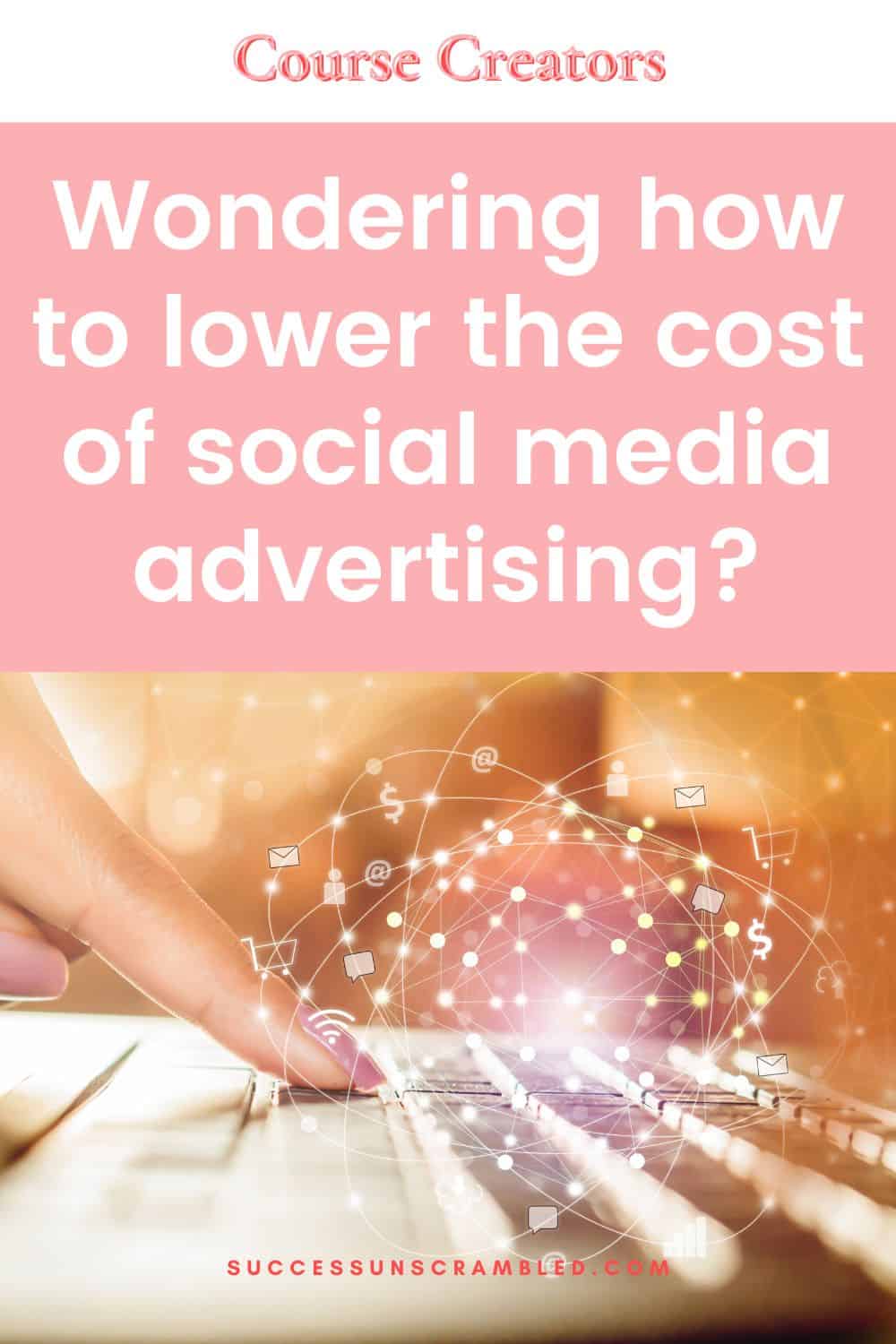Success Unscrambled Podcast

How To Lower the Cost Of Social Media Advertising In 8 Steps
One afternoon I along with my 3 friends decided to step out for lunch. On the way, Sophie asked me to stop at a new Italian restaurant.
She had seen an amazing advertisement and great reviews on Instagram and finally, we had Italian that afternoon. This is the power of social media advertising.
It has revolutionized the way we communicate, build relationships and find new customers.
Social media advertising is a great way to reach a large audience and promote your business, but the cost of social media advertising could make a hole in your pocket.
This guide provides a detailed overview of the cost of social media advertising and how you can make the most of your budget.

Social Media Advertising Glossary
If you’re new to the game of advertising, navigating the complex language and terminology of the industry can be a huge challenge.
Following is a comprehensive guide to the social media advertising glossary, to help you understand the lingo used by industry professionals and ensure that you’re well-equipped to take advantage of all the different platforms.
- CPC (Cost-per-click) – The amount you’ll pay for ad placement when your ad is clicked
- PPC (Pay-per-click) – The amount you pay for the clicks your ads get, meaning you only pay when someone actually clicks your ad.
- CPM (Cost Per Mille) – Also known as Cost per Thousand Impressions, is an amount you pay when your ad is shown a certain number of times.
- CPL(Cost Per Lead) – The amount where you only pay when someone clicks on your ad and takes action, such as signing up for your newsletter or filling out a contact form.
- CPV (Cost-per-view) – You pay for every view generated by your ad. This means you don’t have to worry about clicks or impressions, you only pay for the views that actually count.
- CPA (Cost Per Action) – Also known as cost per acquisition. This is the amount you pay for every user that clicks on your ad, visits your website, or even makes a purchase.
- CTR (Click-through rate) – The CTR is a measure of how many people are clicking on your ad. This number will vary based on the type of ad you’re running and the platform on which you’re running it.
- ROI (Return on investment) – ROI is the return on the money you spend, so you can determine whether your investment is worth it or not.
- ROAS (Return on Ad Spend) – is very focused on the return on ad spend for a specific ad campaign. It is different from ROI because it only considers the cost of the ad but excludes other fees like copywriting, graphic design, ad management etc. The formula to calculate ROAS is Revenue/Ad Spend
Social Media Advertising – Budget’s Guide
When it comes to social media advertising, budgeting is not only important but a challenge as well. I like to think of myself as your personal budget guide when it comes to social media advertising!
To start off, the cost of social media advertising depends on the platform you’re using and the type of ad you’re creating.
To narrow down marketing platforms for your business, you need to have clarity on the monthly budget vs the bidding options on different platforms.
Before you review the average CPC and CPM on various platforms, it is advisable to set a budget and focus on tailoring your campaigns to reach the target audience more effectively.
Minimum Ad Budgets For Different Social Media Platforms
- Facebook = $1/day for impressions, $5/day for clicks
- Instagram = $1/day for impressions,$5/day for clicks
- Linkedin = $2 /click, $10 /day
- Twitter = No minimum
- Youtube = $10/ day
- Pinterest = $2.00 for impressions, $0.10 for clicks
- TikTok = $50/day for campaigns, $20/day for ad groups
Average CPC For Different Social Media Platforms
- Facebook = $0.97
- Instagram = $3.56
- Linkedin = $5.26
- Twitter = $0.38
- Youtube = $3.21
- Pinterest = $1.50
- TikTok = $1.00
Average CPM For Different Social Media Platforms per 1000 impressions
- Facebook = $7.19
- Instagram = $7.91
- Linkedin = $9.68
- Twitter = $6.59
- Youtube = $6.46
- Pinterest = $30
- TikTok = $10
Monthly Ad Spend For Different Social Media Platforms
- Facebook = $200 to $1500
- Instagram = $200 to $1500
- Linkedin = $300 to $1500
- Twitter = $200 to $1500
- Youtube = $200 to $1500
- Pinterest = $200 to $1500
- TikTok = $200 to $1500

CPC vs. CPM vs. Monthly Social Advertising Costs – Table Comparison
Social Media Platform
Average CPC
Average CPM per 1000 impressions
Monthly Ad Spend
$0.97 per click
$7.19
$200 to $1500 per month
$3.56 per click
$7.91
$200 to $1500 per month
$5.26 per click
$6.59
$300 to $1500 per month
$0.38 per click
$6.46
$200 to $1500 per month
Youtube
$3.21 per click
$9.68
$200 to $1500 per month
$1.50 per click
$30
$200 to $1500 per month
TikTok
$1.00 per click
$10
$200 to $1500 per month
Bidding Options For Different Social Media Platforms
- Facebook = CPC, CPM, CPL, CPA
- Instagram = CPC, CPM, CPL, CPA
- Linkedin = CPC, CPM, CPS, CPO
- Twitter = CPC, CPM, CPE, CPF, CPD
- Youtube = CPC, CPM, CPV, CPA
- Pinterest = CPC, CPM
- TikTok = CPC, oCPM, CPV, CPM

How To Start With Social Media Advertising – 8 Practical Steps
Social media advertising is becoming increasingly popular for businesses, but it is not free.
You need to set a budget, as the cost of social media advertising can vary depending on the platform you’re using and the type of ads you’re running. But don’t worry – there are plenty of cost-effective ways to get started.
1. Identify Your Audience
Knowing your target audience is a key step in creating an effective campaign. Too often, people jump in without really knowing who they’re targeting, and the result is an ineffective ad campaign.
Before you start, ask yourself, who are you trying to reach? Once you know who you’re targeting, you can tailor your content, language, and visuals to speak directly to them.
You can also use tools such as Google Analytics or Facebook Insights to get more detailed information about your audience.
2. Select Your Social Media Platform – Start Small!
When it comes to social media advertising, it’s best to start small and work your way up. Trying to manage too many platforms at once can be overwhelming, so it’s important to focus on one at a time.
Once you’ve got a decent number of followers, you can start producing content and running campaigns.
3. Look at Industry Benchmarks
Industry benchmarks can give you an idea of what’s possible for your budget and what kind of return on investment you can expect.
They can also provide a sense of direction and insight on how to structure your campaigns and allocate your resources.
Take a look at the Facebook Ad Library to see what others like you are doing in terms of Ad copy and creatives.
4. Educate Yourself With Relevant Knowledge
You’ve heard time and time again that knowledge is power, and it’s especially true when it comes to social media advertising. If you want to get started with your own campaigns, the best way to do it is to educate yourself.
There are plenty of resources to help you out. With a little bit of research and practice, you’ll be ready to hire someone to run a successful social media advertising campaign for you in no time!
5. Don’t Forget the Organic Strategy and Organic Data
Don’t forget organic strategy and organic data when you’re learning how to start with social media advertising. Sure, paid advertising campaigns have their place, but organic social media activity is important too.
It’s all about building relationships with your customers and potential customers, so it’s important to focus on what brings people to your page.
Organic data can also help you to better target your paid campaigns.
6. Consider Split-testing
If you’re looking to start with social media advertising, consider split-testing different copy, creatives and audiences.
Split-testing is a great way to test out different strategies and see which one works best for your business.
The concept is simple, create two versions of an ad and then test them against each other to see which one performs better. You can test different things, like the headline, the image, the copy, and more (only changing one item at a time).
7. Refresh and Update Your Creatives
Refreshing and updating your creatives is a great way to keep your social media advertising campaigns feeling fresh. The first step is to assess what kind of creatives you need for the campaign.
This could include images, videos, GIFs, or interactive content. Once you’ve identified, you can start creating or sourcing.
It is important to remember that the goal of your campaign is to engage with your audience, so make sure your creative is indeed creative and eye-catching! You can then start testing them across different platforms.
8. Always Keep Mobile in Mind
From smartphones to tablets to wearables, mobile technology is increasingly becoming an integral part of people’s lives.
As a result, it’s essential to ensure that your business stays ahead of the curve. This means optimizing content for smaller screens and creating ads that are easy to read and engage with.
7 Factors That Influence The Cost of Social Media Advertising
Social media advertising can be a great tool to reach new customers and grow your business. But understanding the factors that influence the cost of social media advertising can help you better understand how to lower the cost of your campaigns.
I. Size of your audience
The size of your audience is one of the main factors that influence the cost of a social media ad. The larger the audience (100 million), the more expensive it will be to run a successful ad campaign.
That’s why it’s important to start narrowing down to build up your audience over time. You can do this by targeting specific groups with relevant content and by running targeted ads.
So if you’re looking to maximize your ROI, it pays to define your audience first.
II. Location
Location plays a major role in the cost of social media ads. Different countries, states, and cities all have different costs associated with running a social media campaign.
Factors such as the size of the population, the competitiveness of the market, and the rate of ad saturation all influence the cost of social media ads.
For example, running a campaign in a major metropolitan area may cost more than running a campaign in a smaller city. The size of the target audience can also affect the cost. It is important to identify the right location based on your business.

III. Demographics
Demographics are one of the most important factors to consider when it comes to the cost of social media ads.
Knowing the age and gender of your target audience can help you tailor your content to appeal to them. Income and occupation can help you determine the type of people who are more likely to purchase your products or services.
IV. Season
Seasons play an important role in determining the cost of social media ads. The competition for ad space during the holiday season is usually much higher than the rest of the year.
This leads to higher prices for ads, as companies are willing to pay more to get the word out about their products and services.
As the holiday season approaches, the cost of ads will likely go up, especially for popular social media platforms like Facebook, Twitter, and Instagram.
It’s also important to keep in mind that the cost of ads can vary depending on the time of day and day of the week. Ads placed during peak times or on weekends usually cost more than ads placed during off-peak times.
Quick note: It’s important that you keep your Facebook ad running 24/7 to get the best return on investment so peak and off-peak don’t apply to Facebook Ads.
V. Industry
The industry is a major factor that influences the cost of social media ads. Different industries have different levels of competition, which can affect the cost of social media ads.
For example, a highly competitive industry like the automotive industry will have a higher cost per click than a less competitive industry like the pet food industry.
A larger target audience will require more ad impressions in order to reach the desired number of people, which will increase the overall cost.
VI. Ad Relevancy
Ad relevancy is an important factor when it comes to social media advertising. Ads that are relevant to the target audience will have a higher chance of success. Another factor is ad placement.
Ads should be placed in appropriate locations on the platform to be seen by the right people. The quality of the ad itself is important. Ads should be engaging, well-designed, and contain relevant content.
VII. Ad Quality
The quality of an ad is one of the most important factors that influence the cost of running a social media ad. The higher the quality of the ad, the more effective it is likely to be.
A few things that affect the quality of an ad on Facebook include the domain name, and the legal features around the website associated with your domain name like privacy policy, terms and conditions, etc.
Another important factor is how people are engaging with your ad.
How To Lower Cost Of Social Media Advertising – 8 Easy Steps
Social media advertising is becoming an increasingly popular way for businesses to reach their target market.
However, it can be costly, especially for small businesses with limited budgets. Fortunately, there are some ways to lower the cost of social media advertising.
1. Choose a Less Expensive and Narrow Audience
One of the best ways to lower the cost of social media advertising is to narrow down your audience.
By narrowing your target audience to a specific demographic or location, you can get more bang for your buck and limit your ad spend. You can also use features like A/B testing to determine which ads are successful and which are not.
A quick tip: Your audience size shouldn’t be smaller than 500,000 if you’re running a lead Ad campaign.
2. Tailor Your Ads to Your Ideal Buyer Persona
Tailoring your ads to your ideal buyer persona is essential for effective social media advertising.
Knowing who your ideal customer is and what they need will allow you to craft compelling and effective ads. You’ll also want to make sure you are targeting the right audiences on the right networks.
3. Focus on user retention
User retention is essential to the success of any business. It costs much less to keep a customer than to acquire a new one. That’s why it’s important to focus on user retention, finding ways to keep customers engaged and coming back for more.
One way to do this is to lower the cost of social media advertising. By using re-targeting ads and optimizing your campaigns, you can reach the right people at the right time without breaking the bank.
You can also use customer feedback to improve your campaigns and create personalized experiences that will keep customers coming back. Finally, don’t forget the value of offers and discounts.
4. Reduce Your Ad Frequency
This means not bombarding your audience with ads all the time. Instead, you should be strategic when it comes to targeting and timing. Aim to target the right audience at the right time, and you’ll be able to get more out of your ad budget.
You can also look at reducing the frequency of your ads by running them in segments. This way, you’ll be able to test different strategies and see which ones work best.
By taking the time to optimize your ads, you can make them more effective and lower your overall cost.
Yes, your potential audience may need to see content from you 67 times before taking action but limit your ad frequency to 1.5 times.
5. Set a Campaign Budget
Setting a campaign budget is a great way to make sure your money is working for you. You can do this by making a list of all your expenses and then subtracting any income you make.
This will give you an idea of how much you have to spend each month. Once you have this figure, you can start setting a budget for yourself.
6. Cap Your Bids
One of the best ways to lower the cost of social media advertising is to cap your bids. By capping your bids, you can control the amount of money you are willing to pay for each impression or click.
This helps you to target your audience more effectively and helps you to stay within your budget. It also helps you to focus your campaigns on the most important metrics, such as cost-per-click and cost-per-engagement.

7. Think about obtaining User-Generated Content
User-Generated Content (UGC) is an increasingly popular way to supplement your social media presence and lower your costs of advertising. The key is to find creative ways to engage your followers and encourage them to generate content for you.
By offering an incentive to your followers, you can generate a lot of engagement and content. You can also create a hashtag and encourage users to post content related to it.
Plan to collaborate with influencers and ask them to post about your product or service. By taking advantage of these strategies, you can easily obtain the UGC you need to lower your social media advertising costs.
8. Warm Up Your Account
When you create a new ad account that doesn’t have any history on any of the ad platforms it is important to warm it up first by running specific types of campaigns.
These types of campaigns include video views and lead ad campaigns.
After running these kinds of campaigns for 1-2 months platforms like Facebook can then trust you with their audience to run conversion campaigns.
This means your cost of advertising on social media will be lower compared to brand-new accounts that are targeting the same audience.
Conclusion
Social media advertising is an invaluable tool for businesses of all sizes. It’s a great way to reach a broad audience, build brand awareness, and increase conversions.
However, it can also be a costly endeavour. It’s important to have a firm understanding of the costs associated with social media advertising and how to make the most of your budget.
Make sure ads are relevant to your audience and adjust them as necessary to make them as successful as possible.
Remember, the audience on social media is an extension of your brand. They deserve to be treated as such and you can do that by creating engaging ads that are worth their time.
Need help with advertising on Facebook? Check out this resource about Facebook Ads packages here.






 Visit Podcast Website
Visit Podcast Website RSS Podcast Feed
RSS Podcast Feed Subscribe
Subscribe
 Add to MyCast
Add to MyCast